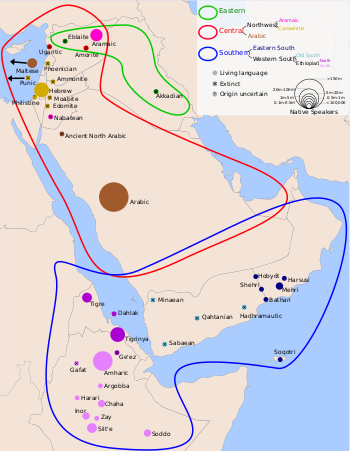اللغات السامية الجنوبية
| السامية الجنوبية | |
|---|---|
| التوزيع الجغرافي: | اليمن، عُمان، إثيوپيا، إرتريا |
| التبويب اللغوي: | الأفرو-آسيوية
|
| الأقسام: | |
| Glottolog: | None |
التوزع التاريخي التقريبي للغات السامية | |
السامية الجنوبية is a putative branch of the Semitic languages, which form a branch of the larger Afro-Asiatic language family, found in (North and East) Africa and Western Asia.
. . . . . . . . . . . . . . . . . . . . . . . . . . . . . . . . . . . . . . . . . . . . . . . . . . . . . . . . . . . . . . . . . . . . . . . . . . . . . . . . . . . . . . . . . . . . . . . . . . . . . . . . . . . . . . . . . . . . . . . . . . . . . . . . . . . . . . . . . . . . . . . . . . . . . . . . . . . . . . . . . . . . . . . .
التاريخ
The "homeland" of the South Semitic languages is widely debated, with sources such as A. Murtonen (1967) and Lionel Bender (1997)[1] suggesting an origin in Ethiopia and others suggesting the southern portion of the Arabian Peninsula.[2] A 2009 study based on a Bayesian model to estimate language change concluded that the latter viewpoint is more probable.[3] This statistical analysis could not estimate when or where the ancestor of all Semitic languages diverged from Afroasiatic but it suggested that the divergence of the East, Central, and South Semitic branches occurred in the Levant.[4] According to a theory believed by many now, Semitic originated from an offshoot of a still earlier language in North Africa and desertification made some of its speakers migrate in the fourth millennium BC into what is now Ethiopia, others northwest into West Asia [5]
التبويب
South Semitic is divided into two uncontroversial branches:[6]
- الغربية
- Old South Arabian – possibly extinct, formerly believed to be the linguistic ancestors of modern South Arabian Semitic languages, modern South Arabian now being classified as Eastern South Semitic. The Razihi language and Faifi language are probably descendants.
- Ethiopian Semitic (Ethio-Semitic, Ethiosemitic, Ethiopic) on the southern coast of the Arabian Peninsula and found across the Red Sea in the Horn of Africa, mainly in modern Ethiopia and Eritrea.
- الشرقية
- Modern South Arabian. These languages are spoken mainly by small minority populations on the Arabian Peninsula in Yemen (Mahra and Soqotra) and Oman (Dhofar).
الديمغرافيا
The Ethiopian Semitic languages collectively have by far the greatest numbers of modern native speakers of any Semitic language other than Arabic. Eritrea's main languages are mainly Tigrinya and Tigre, which are North Ethiopic languages, and Amharic (South Ethiopic) is the main language spoken in Ethiopia (along with Tigrinya in the northern province of Tigray). Ge'ez continues to be used in Eritrea and Ethiopia as a liturgical language for the Orthodox Tewahedo churches.
Southern Arabian languages have been increasingly eclipsed by the more dominant Arabic (also a Semitic language) for more than a millennium. Ethnologue lists six modern members of the South Arabian branch and 15 members of the Ethiopian branch.[7]
انظر أيضاً
المراجع
- ^ Bender, L. (1997). "Upside Down Afrasian". Afrikanistische Arbeitspapiere. 50: 19–34.
- ^ Hetzron, Robert (1972). Ethiopian Semitic: Studies in Classification (in الإنجليزية). Manchester University Press. p. 122. ISBN 9780719011238.
- ^ Kitchen, Andrew; Ehret, Christopher; et al. (22 June 2009). "Bayesian phylogenetic analysis of Semitic languages identifies an Early Bronze Age origin of Semitic in the Near East". Proceedings of the Royal Society B: Biological Sciences. 276 (1665): 2703–2710. doi:10.1098/rspb.2009.0408. PMC 2839953. PMID 19403539.
- ^ Kitchen, A.; Ehret, C.; Assefa, S.; Mulligan, C. J. (29 April 2009). "Bayesian phylogenetic analysis of Semitic languages identifies an Early Bronze Age origin of Semitic in the Near East". Proceedings of the Royal Society B: Biological Sciences. 276 (1668): 2703–10. doi:10.1098/rspb.2009.0408. PMC 2839953. PMID 19403539.
- ^ The Origin of the Jews: The Quest for Roots in a Rootless Age By Steven Weitzman page 69
- ^ Faber, Alice (1997). "Genetic Subgrouping of the Semitic Languages". In Hetzron, Robert (ed.). The Semitic Languages. Routledge. pp. 3–15.
- ^ "South". Ethnologue. Retrieved 2017-07-04.

